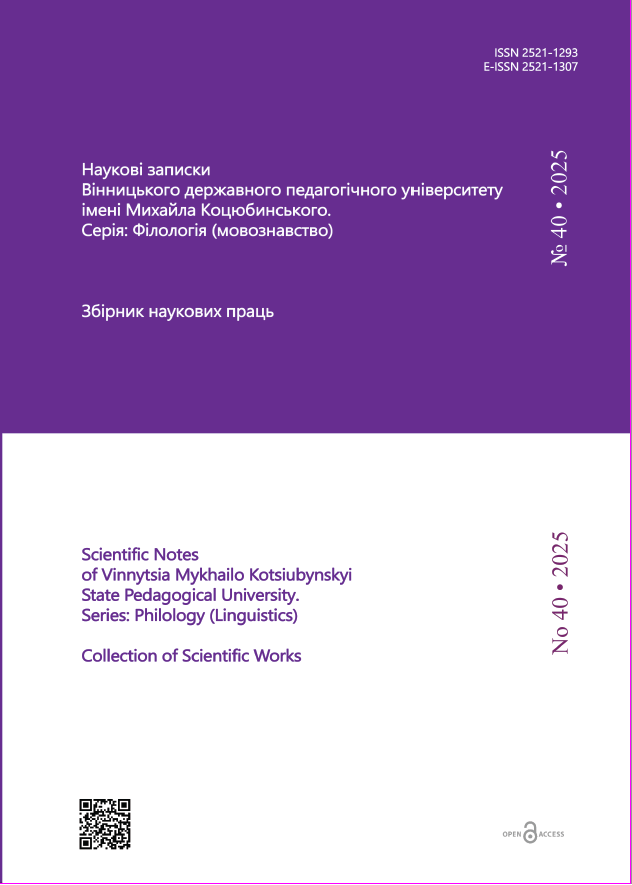Traditional birth text of Podolians: attributive and quantitative codes of ritual text
https://doi.org/10.31652/2521-1307-2025-40-11Published 2025-07-07
Keywords
- Podolia, birth rite, linguistic and cultural text, text code, rite, name, Podolian dialects

This work is licensed under a Creative Commons Attribution 4.0 International License.
How to Cite
Abstract
The topicality of the work is conditioned by the need to learn the Ukrainian linguistic world-image, identification of verbal means that preserve the collective cultural code. Dialectal worldview is one of the varieties of verbal worldview, which reflecting the peculiarities of the regional worldview, represents the features of the speakers’ spiritual and material worlds perception, imprinted in the language. A dialect text is a reliable source for researching a dialectal worldview specifically and All-Ukrainian one on the whole. The birth text of Podolians is considered as a linguistic and cultural text based on the unity of object, verbal, quantitative, verbal and anatomical codes. The aim of the article is an ethnolinguistic analysis of the Podolian genitive text through the prism of key linguocultural ideas represented in the terminology of the attributive and quantitative codes of the ritual text. Each code of the ritual text is formed by a wide corpus of analyzed names, most of which are autochthonous, Slavic in origin. The research was carried out on the dialect material collected in 62 settlements of Vinnytsia region by expedition method. The work also uses general scientific (analysis and synthesis, comparison, descriptive methods) and linguistic methods: textological (contextual analysis), comparative-historical, and the method of component analysis. It has been established that the customary instructions in the Podolian linguistic and cultural birth text, recorded in the studied territory, are the manifestation of the archaic ideas of our ancestors about the animism of the surrounding world: water, trees, earth, objects and plants are endowed with the qualities of living beings, and therefore are able to transmit their properties to humans by contacting with a person. Number is one of the important categories in the mythopoetic image of the world, and therefore in folk culture it is an object of symbolization and evaluation: pursuing matrimonial goals, our ancestors actively observed the parity of actions and objects in the birth rite. The unity of the structural elements of the Podolian birth ceremony, its nominations with the corresponding elements of the Slavs or even more broadly the Europeans testifies to its archaicness, taboo nature, and relative conservatism. In view of this, further studies of this subject have a wide heuristic potential for establishing Ukrainian-non-Slavic connections in the field of onomasiology, etymology and ethnology.
Downloads
References
- Бігусяк, М. (1997). З лексики родильного обряду у гуцульських говірках. Гриценко П. Ю. (ред.), Український діалектологічний збірник. Кн. 3 : Пам’яті Тетяни Назарової. Київ : Довіра, с. 293-301.
- Гороф’янюк, І. (2023). Номінація хліба в українських центральноподільських говірках: загальнослов’янський етнолінгвістичний контекст. Slavia Orientalis, vol. LXXII, NR 4, c. 863-875. DOI: 10.24425/slo.2023.148590 DOI: https://doi.org/10.24425/slo.2023.148590
- Гороф’янюк, І. (2023). Традиційний родильний текст подолян: персонажний та акціональний коди обрядового тексту. Павликівська Н. М. (ред.), Мовна картина світу українців в її індивідуальному, регіональному та загальнонаціональному виявах: колективна монографія. Вінниця: ФОП Добрянська О. Г., ТОВ «ДРУК-ПЛЮС», с. 50-73.
- Гороф’янюк, І. В. (2024). Традиційний родильний текст подолян: анатомічний і вербальний коди обрядового тексту. Наукові записки Вінницького державного педагогічного університету імені Михайла Коцюбинського. Серія: Філологія (мовознавство), вип. 39, с. 97-107. https://doi.org/10.31652/2521-1307-2024-39-09 DOI: https://doi.org/10.31652/2521-1307-2024-39-09
- Грушевський, М. (2011). Дитина у звичаях і віруваннях українського народу / 2-ге вид., стер. Київ : Либідь.
- Жайворонок, В. (2006). Перехрестя. Знаки української етнокультури: словник-довідник. Київ : «Довіра».
- ЕССУ (2005) – Енциклопедичний словник символів культури України. Вид. 3-е, доп., випр. / За заг. ред. В. П. Коцура, О. І. Потапенка, В. В. Куйбіди. Переяслав-Хмельницький державний педагогічний університет ім. Г. Сковороди. Корсунь-Шевченківський : ФОП Гавришенко В. М.
- ЕСУМ (1982–2012) – Етимологічний словник української мови: в 7 т. Ред. кол.: О. С. Мельничук (гол. ред.), І. К. Білодід, В. Т. Коломієць, О. Б. Ткаченко. АН УРСР. Ін-т мовознавства ім. О. О. Потебні. Київ : Наукова думка.
- Матеріали до словника подільського говору (2021) / Упор. І. В. Гороф’янюк. Вінниця : ТОВ «ТВОРИ», 461 с.
- Strahov, A. (1991). Kul`t chleba u vostočnyh slavjan opyt etnolingvističeskogo issledovanija. München. DOI: https://doi.org/10.3726/b12274





